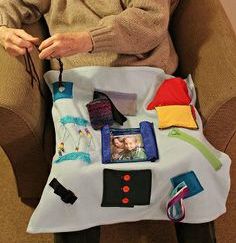Therapeutic Touch & Sensory Quilt
“Busy Hands & Mind”

-
Sustain a clients natural need to keeps hands engaged and active
Pre-amble: Market and Economic Impact
As of 2013, there were an estimated 44.4 million people suffering with dementia worldwide. This number is expected to increase to an estimated 75.6 million by 2030, and 135.5 million by 2050. Alzheimer´s Disease will be one of the biggest burdens of the future society showing dramatic incidence rates: every 69 seconds someone in the US develops Alzheimer´s Disease, by mid-century someone will develop Alzheimer´s Disease every 33 seconds. In 2013 44 million people will be affected with the disease worldwide In the US Alzheimer´s Disease is now the 6th leading cause of death across all ages. It was the fifth leading cause of death for those aged 65 and older. Since the incidence and prevalence of Alzheimer´s Disease increase with age, the number of patients will grow dramatically with our society getting older. By 2050 we need to expect that patient numbers have tripled to 135 million Alzheimer´s Disease patients worldwide.
The Alzheimer´s Disease market is currently estimated at $ 5 billion annually with projections that show the market potential will surpass $ 20 billion by 2020.
The global economic impact of Alzheimer´s Disease is shown by the worldwide cost of $ 640 billion, which exceeds 1% of gross world product. It can be seen as the most significant health crisis in the 21st century.
The 2010 annual costs of treating and caring for patients worldwide was an estimated US$604 billion and in the the US alone was $183 billion. This figure is expected to increase to $ 1.1 trillion in 2015. Alzheimer´s Disease is becoming the third most expensive disease counting for 30% of the US healthcare costs. The medical costs for Alzheimer´s Disease patients are three times higher than for other older patients. There is also a big financial impact for the individuals and their families as the out-of-pocket-costs for the Alzheimer´s Disease patients are higher than for any other disease. As expenses for assisted living or nursing homes can often not be afforded, 70% of Alzheimer´s Disease patients live at home resulting in high impact of family’s health, emotional well-being as well as their employment and financial security.
Cost of Treatment
Currently there is no disease-modifying treatment for the Alzheimer´s Disease on the market. The disease usually is diagnosed late when already 70% of the nerve cells in the brain are dead. Several high-impact nutritional and supplementary treatment products are being developed and should particularly impact on prevention. Five drugs are approved and marketed which treat the symptoms. Better understanding of the underlying biology will lead to several new axes of treatment in different stages of clinical testing. The impact of a disease-modifying treatment can be huge: Delaying the onset of Alzheimer´s Disease by 5 years starting 2015 could result in a prevalence reduced by 5.9 million (43%) in 2050 in the US alone. Expressed in money, a delay of onset of 5 years would could result in savings of $ 447 billion of the total expected costs of $ 1.078 billion in the US alone.
Costs of informal care (unpaid care provided by families and others) and the direct costs of social care (provided by community care professionals and in residential home settings) contribute similar proportions (42%) of total costs worldwide, while direct medical care costs are much lower (16%).
So how can WE help?
We cannot claim to be able to mitigate nor have a direct impact on the projected ageing population growth and relevant Dementia/Alzheimer’s statistics. However, we can offer a number of Home Care Services solutions to help families who are caring for a loved sufferingwith Dementia/Alzheimer’s? To review our full line of services, please visit our home page… under Services. For the purpose of this article we are offering a tool to help the family caregiver gain some control and management over their loved one who may be suffering with these deceases… A Therapeutic Touch and Sensory Quilt. This is not a typo… “QUILT”.
According to the College of Nursing at the University of Arkansas for Medical Sciences, Little Rock 72205 – U.S.A.
Abstract
Agitated behaviour in persons with Alzheimer’s disease (AD) presents a challenge to current interventions. Recent developments in neuro-endocrinology suggest that changes in the hypothalamic-pituitary-adrenal (HPA) axis alter the responses of persons with AD to stress. Given the deleterious effects of pharmacological interventions in this vulnerable population, it is essential to explore non-invasive treatments for their potential to decrease a hyper-responsiveness to stress and indirectly decrease detrimental cortisol levels. This within-subject, interrupted time-series study was conducted to test the efficacy of therapeutic touch on decreasing the frequency of agitated behavior and salivary and urine cortisol levels in persons with AD. Ten subjects who were 71 to 84 years old and resided in a special care unit were observed every 20 minutes for 10 hours a day, were monitored 24 hours a day for physical activity, and had samples for salivary and urine cortisol taken daily.
The study occurred in 4 phases:
- Baseline (4 days),
- Treatment (therapeutic touch for 5 to 7 minutes 2 times a day for 3 days),
- Post-treatment (11 days), and
- Post – “wash-out” (3 days).
An analysis of variance for repeated measures indicated a significant decrease in overall agitated behaviour and in 2 specific behaviours, vocalization and pacing or walking, during treatment and post-treatment. A decreasing trend over time was noted for salivary and urine cortisol. Although this study does not provide direct clinical evidence to support dysregulation in the HPA axis, it does suggest that environmental and behavioral interventions such as therapeutic touch have the potential to decrease vocalization and pacing, 2 prevalent behaviors, and may mitigate cortisol levels in persons with AD.
Alzheimer’s patients, particularly those in the more advanced stages can get quite tense and fidgety. To help relieve stress and tension in these special people, we have developed our own line of fidget quilt. As the disease worsens, hands become more restless and fidgety. These quilts offer something tangible to occupy their hands… providing gentle yet constant therapeutic stimulation for the mind and soul. Resulting in an enhanced quality of life for both the patient and the caregiver.
So how do our quilts work?
They help to stimulate curiosity, memories and awareness, provide a sense of purpose and of “doing something”, and this having a calming & soothing affect on the user.

-
Active Hands & Mind Quilt – Engaging, calming and soothing clients suffering with Alzheimer’s
Our quilts are more than just a “tangible repository of memories.”
They are user-friendly, functional, induce comfort and warmth… providing a constant reminder of a family that loves them. Whether it’s the combination of textures used (softly contoured corduroy, faux fur, textured linens,,, etc) this quilt will provide the kind of tactile stimulation that will calm and soothe your loved one. It keeps their anxious hands engaged, mind occupied and their legs warm. Great for anyone, this is a must for anyone with progressive dementia or alzheimer’s.
Because people with Alzheimer’s and other dementia experience an ongoing decrease in their brain’s functions, simple, repetitive movements and sensory experiences become more important. That’s where our lap quilts come in. With their intentional variety of textures and extra accessories, fidget quilts provide comfort through the hands and the eyes. For a men’s quilt, you might want to personalize with items of a past hobby or interest (nuts, bolts, golfing or fishing items). We safely fasten the items or string them so that the patient will fidget with the items from one end of the lace to the other. Our quilts are handy & conveniently sized (24”X 30”) made from colourful patterns to entertain the eyes and with a warm backing to keep the lap warm. Attached to the quilts are buttons of various sizes to captivate the fingers and the eyes, a zipper, strips of cloth, and shoe laces, which can be tied or manipulated in a number of ways (over and over again). There’s a plush toy, shapes, a pocket with things in them, jingle bells and anything else that may be of significance to your loved one. Our quilts can be a Godsend to a caregiver while bringing significant relief to the patient… through it’s calming and soothing therapeutic affect.
We take extreme care to ensure that all items are safely secured so that they cannot become free or removed (unless cut out) to avoid any potential choking hazard. The laces, fabric strips or anything that dangles are also cut to lengths whereby they cannot be used as a means of restraining, or become a ligature capable harming your loved one.
Our quilts are easy care for and washable… of course anything that cannot be washed, is fastened so that it can be easily unclipped and reattached after washing.
The quilt will give the family a feeling of joy watching their loved one’s restless fingers occupied with all the different activities and textures that gives them that soothing and calming disposition.
They make wonderful birthday, Christmas, anniversary, or any special occasion gift, or to simply say “I Care and I love you”
We engage the family’s input when creating a custom quilt or you can opt for a generic quilt already pre-manufactured, incorporating a number of therapeutic sensory activities and items.
Our core business is providing Home Care for seniors in their homes or wherever home may be. However, we also understand that although you may not yet require our assistance, you can still benefit from something that we can offer… like our “Busy Hands & Mind Quilt”.
Our quilts are inexpensive, provide such rewarding results and delivered for free anywhere in Toronto, Mississauga, Oakville and Brampton. Outside of these areas there “MAY” be an additional charge for shipping… but we can discuss it. Of course outside of Ontario, national and international orders shipping costs are extra.
Please contact us today, to discuss the order of one of our Quilts, or to discuss any challenges you may be facing and how our services can help you remain independent, protected, safe, and in you home / community.
You got questions, we have answers: (905) 785-2341 or email us at
